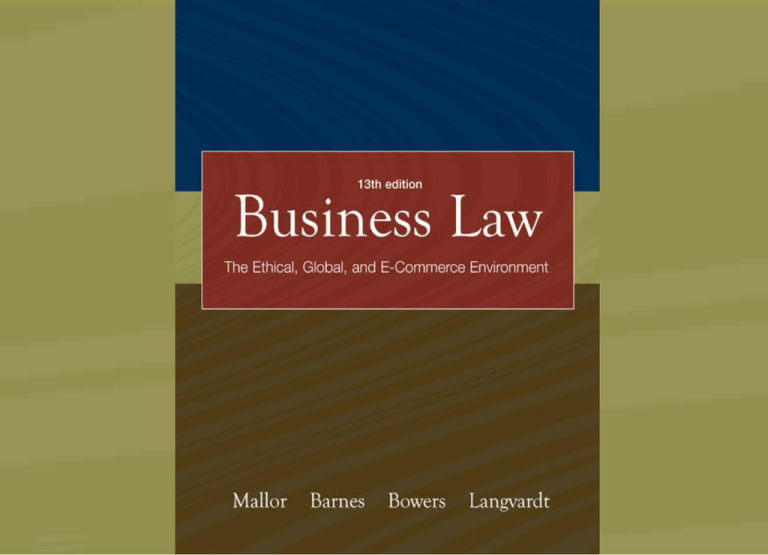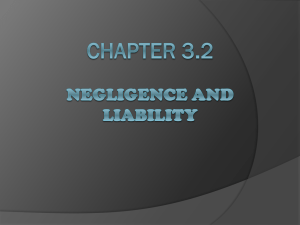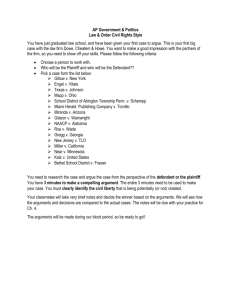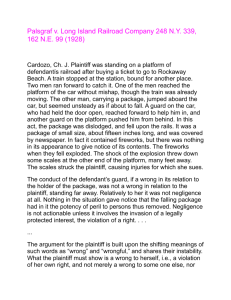
P A R T
2
Crimes & Torts
Crimes
Intentional Torts
Negligence & Strict Liability
Intellectual Property & Unfair
Competition
McGraw-Hill/Irwin Business Law, 13/e
© 2007 The McGraw-Hill Companies, Inc. All rights reserved.
C H A P T E R
7
Negligence & Strict Liability
“Mistakes are a fact of life. It is the response to error that counts.”
Nikki Giovanni
Learning Objectives
The
Elements of Negligence
Defenses to Negligence
Special Doctrines Related to Negligence
7-4
Negligence
The
elements of a negligence claim are
Defendant owed a duty of care to plaintiff,
Defendant committed a breach of duty,
Breach was actual and proximate cause of
Injury experienced by the plaintiff
7-5
Duty of Due Care
In general, a defendant owed the plaintiff a
duty of reasonable care if the plaintiff would
foreseeably be at risk of harm from the
defendant’s conduct
If a duty existed, then the question is whether
the defendant acted as a reasonable person of
ordinary prudence would have acted under the
same or similar circumstances
Reasonable person standard
7-6
Causation and Injury
Injuries may include bodily or emotional
injury, and property or economic damage
Causal link requires:
7-7
Actual cause: plaintiff would not have been
hurt “but for” defendant’s breach of duty (act
or omission)
Proximate cause: plaintiff’s injury was
foreseeable consequence of defendant’s act or
omission
Causation and Injury
An important doctrine concerning causation
is res ipsa loquitur (the thing speaks for itself)
Applies when:
(1) defendant has total control
of the instrument of harm, (2)
harm would not occur in the
absence of negligence, and (3)
plaintiff not responsible for
his own injury
7-8
Defenses to Negligence Claim
Contributory negligence is
the plaintiff ’s failure to
exercise reasonable care
for his/her own safety
Assumption of risk is the
plaintiff’s voluntary
consent to known danger
7-9
Special Doctrines
Premises liability cases are based on the duty a
property owner or tenant has to those on
property and vary with type of person:
Invitee, licensee, or trespasser
Negligence per se applies when defendant’s
violation of law creates a breach of duty and
may allow the plaintiff to win by suffering
harm the law was enacted to prevent
7 - 10
Special Doctrines
Strict liability is liability imposed upon a
defendant regardless of defendant’s fault
7 - 11
A social policy decision that risk associated
with an activity, especially an abnormally
dangerous activity (including manufacturing),
should be borne by those who pursue it rather
than by innocent persons exposed to that risk
Basis for product liability cases
Test Your Knowledge
True=A, False = B
A duty of due care may arise only if a
contract or statute creates such a duty
Without a duty, there can be no breach
Res ipsa loquitur means the thing speaks for
itself and is related to causation
Negligence per se occurs when a plaintiff
contributed to his or her own injury
7 - 12
Test Your Knowledge
True=A, False = B
Contributory negligence and comparative
negligence mean the same thing
Assumption of risk is the plaintiff’s
voluntary consent to a known danger
Imposing strict liability is a social policy
decision
7 - 13
Test Your Knowledge
Multiple Choice
Elements of a negligence claim include:
duty of due care
breach of the duty of due care
causation (actual and proximate)
injury to plaintiff
all of the above
The reasonable person test focuses on:
7 - 14
(a)
(b)
(c)
(d)
(e)
(a) Defendant’s behavior
(b) Defendant’s intent
Test Your Knowledge
Multiple Choice
The causation element requires proof of:
actual cause (the “but for” test)
proximate cause
sufficient cause
both (a) and (b), but not (c)
A property owner or tenant must exercise
reasonable care for the safety of his/her:
7 - 15
(a)
(b)
(c)
(d)
(a) Invitees
(b) Licensees
(c) Trespassers
Thought Question
Do you think tort reform is necessary?
7 - 16










